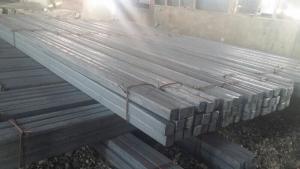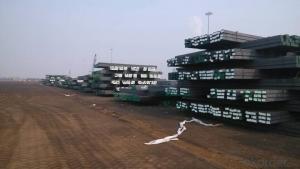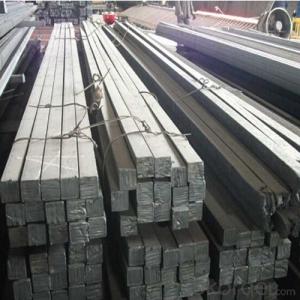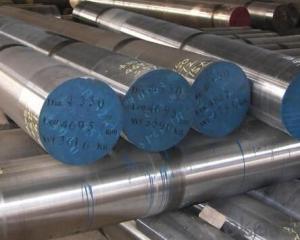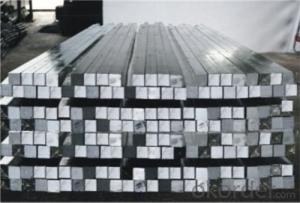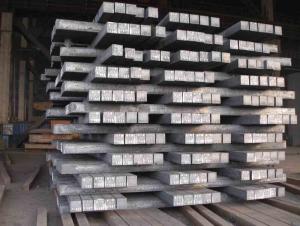Steel Square Bar With Chemical Element Boro
- Loading Port:
- China main port
- Payment Terms:
- TT OR LC
- Min Order Qty:
- 25 m.t.
- Supply Capability:
- 10000 m.t./month
OKorder Service Pledge
OKorder Financial Service
You Might Also Like
Product Description
There are two types of Square Bar, one is hot rolled square bar and other one is cold drawn square bar. Our principal products is hot rolled square bar. We dedicate to products with material Q195 and Q235. We offer products with high quality and low price.
Specifications
-Standard: GB,
-Grade: Q195/Q235 or equivalent.
-Chemical Composition:
Standard | Grade | Element (%) | ||||
C | Mn | S | P | Si | ||
GB | Q195 | 0.06~0.12 | 0.25~0.50 | ≤0.050 | ≤0.045 | ≤0.30 |
GB | Q235B | 0.12~0.20 | 0.30~0.70 | ≤0.045 | ≤0.045 | ≤0.30 |
-Mechanical Properties:
Mechanical Properties | Grade | Steel diameter(mm) | |||
≤16 | 16~40 | 40~60 | 60~100 | ||
Yield Point Δs/MPa | Q195 | ≥195 | ≥185 | - | - |
Q235 | 235 | 225 | 215 | 205 | |
Tensile Strength | Q195 | 315~390 | |||
Q235 | 375~500 | ||||
Elongation δ5% | Q195 | ≥33 | ≥32 | - | - |
Q235 | 26 | 25 | 24 | 23 | |
Measures (Big measures):
(Section of Hot-rolled Square Steel Bar)
-Length of a side and Theoretical weight of Square Bar (Big measures).
Length of a side(mm) | Theoretical weight(kg/m) | Length of a side(mm) | Theoretical weight(kg/m) |
53 | 22.05 | 80 | 50.24 |
56 | 24.61 | 85 | 56.72 |
60 | 28.26 | 90 | 63.59 |
63 | 31.16 | 95 | 70.85 |
70 | 38.49 | 100 | 78.50 |
75 | 44.16 |
Notes:
1, The theoretical weights in the list, base on the density of 7.85 g/cm3.
2, Formula for theoretical weight of Square bar: a(length of a side) * a * 0.00785
3, The numbers with *mean that they are not regular or we don’t offer them.
-Regular length of Square Bar:
Steel | Length of a side (mm) | Length of steel (m) |
Normal steel | < 25 | 4~10 |
> 25 | 3~9 | |
Steel of high quality | All measure | 2~6 |
Tool steel >75 | 1~6 |
Usage/Applications
-The Square Steel is normally used as structure steel.
-Row material for other structure steel like steel angles, channels, I-beams, H-beams, etc…
-Row material for steel pipes.
Packaging & Delivery
-Packing Detail:
1, The products can be packed in bundles by steel wires.
2, The weight of each bundle no exceed normally 3 tons.
-Marks: We make tag marks and color marks for each bundle. The tag marks with white background and red company log will be tied up to each bundle. The information is usually including basic information of company and products like product name, specification, etc...and other information required by customers. As for color marks, we will paint both ends of each bundles to make sure that it will be more convenient for customers to distinguish theme from other products.
-Delivery Detail: 30~45 working days after receive buyer’s T.T. or L/C.
Payment:
-Invoicing on theoretical weight or actual weight as customer’s request.
-FOB, CFR or CIF.
-Regular terms of payment:
1, 30% payment in advance, the remaining balance (70% payment) against the copy of B/L.
2, 30% payment in advance, the remaining balance (70% L/C) against the copy of B/L.
3, Negotiable.
-The payment terms will be written in contraction detailed.
- Q: How does a steel square assist in determining the correct miter angle?
- A steel square assists in determining the correct miter angle by providing a precise tool for measuring and marking angles on wood or other materials. It consists of a long metal blade with a ruler-like scale and a shorter perpendicular blade, forming a right angle. To determine the correct miter angle, you can use the steel square in several ways. One method is by placing the longer blade along the edge of the material you want to cut, and then aligning the shorter blade with the desired angle. The scale on the blade allows you to accurately measure the angle and make adjustments as needed. Once the angle is set, you can mark the material accordingly for cutting. Another way to use a steel square for miter angle determination is by creating a reference line. By aligning the longer blade with one edge of the material and the shorter blade with another edge, you can establish a reference line at the intersection of the two blades. This reference line can then be used to guide the cutting process and ensure the correct miter angle. Overall, a steel square is a versatile tool that allows for precise measurement and marking of angles, making it an essential aid in determining the correct miter angle. Its accuracy and ease of use make it indispensable for carpenters, woodworkers, and anyone else working with angles in construction or DIY projects.
- Q: The difference between cold and hot galvanized steel hollow where
- Hot rolling process is: the ingot directly into square tube, and then galvanized, also known as seamless pipe.Usually than cold-rolled steel hot-rolled square steel prices high.
- Q: How do you use a steel square to measure and mark 281.25-degree angles?
- To use a steel square to measure and mark a 281.25-degree angle, you would first align one edge of the square with a reference line. Then, locate the degree markings on the square and find the 281.25-degree mark. Place a mark or draw a line at that point on your work surface to indicate the desired angle.
- Q: How do you use a steel square for marking roof gable angles?
- To mark roof gable angles using a steel square, follow these steps: Begin by determining the desired pitch or slope for the gable. Typically, this is specified as rise over run, such as 6/12 (indicating a 6-inch rise over a 12-inch run) or 8/12. Next, position the steel square on the gable rafter. Align the long side of the square, known as the blade, with the edge of the rafter. The short side, called the tongue, should rest against the top of the rafter. Adjust the steel square until the desired pitch or slope lines up with the edge of the rafter. Slide the square up or down the rafter until the markings on the square indicate the desired pitch. Once the steel square is correctly positioned, mark the angle on the rafter using a pencil or marker. Trace along the tongue of the square or extend lines from the markings on the square using a straight edge. Repeat this process for each gable rafter, ensuring that all angles are consistently marked. By using a steel square in this way, you can precisely mark the angles for roof gables, guaranteeing proper alignment and pitch. Remember to double-check your measurements and markings before making any cuts or adjustments to the rafters.
- Q: What are the different angles that can be measured with a steel square?
- A steel square can be used to measure various angles, including right angles (90 degrees), acute angles (less than 90 degrees), obtuse angles (greater than 90 degrees but less than 180 degrees), and straight angles (180 degrees).
- Q: What are some common features of steel squares?
- Some common features of steel squares include: 1. Material: Steel squares are made from high-quality steel, which gives them durability and strength. 2. Shape: Steel squares are typically shaped like a right-angled triangle, with one long side and two shorter sides forming a 90-degree angle. 3. Accuracy: Steel squares are designed to provide accurate measurements and angles. The edges and corners are precisely machined to ensure precise and consistent results. 4. Markings: Steel squares often have markings along the edges, allowing users to measure and mark specific lengths or angles. 5. Graduations: Steel squares may have graduations or scales engraved or printed on the surfaces, enabling users to measure angles or distances more easily. 6. Versatility: Steel squares can be used for a variety of purposes, including measuring, marking, and checking right angles, as well as for determining and transferring angles. 7. Size and weight: Steel squares come in various sizes, typically ranging from small pocket-sized squares to larger squares used for more heavy-duty applications. The weight of a steel square depends on its size and thickness. 8. Corrosion resistance: Steel squares are often treated or coated to enhance their resistance to rust and corrosion, ensuring a longer lifespan. 9. Stability: Steel squares are designed to be stable and rigid, providing a reliable reference for accurate measurements and layout work. 10. Multi-functionality: Some steel squares may feature additional features, such as built-in spirit levels, scribing tools, or adjustable components, making them more versatile and convenient for specific applications.
- Q: Can a steel square be used for checking the squareness of picture frames?
- Yes, a steel square can be used for checking the squareness of picture frames. A steel square, also known as a framing square or carpenter's square, is a versatile tool commonly used in woodworking and construction. Its 90-degree angle and straight edges make it ideal for measuring and checking right angles. When using a steel square to check the squareness of a picture frame, you can place it against the corners of the frame to ensure they are perfectly perpendicular. By aligning the edges of the square with the frame corners, any discrepancies in squareness can be easily identified and corrected. Therefore, a steel square is a reliable tool for ensuring that picture frames are properly squared.
- Q: How do you use a steel square to determine the height of an object?
- To determine the height of an object using a steel square, you can place one edge of the square against the base of the object and extend it vertically until it touches the top. Then, you can measure the distance from the base to the point where the square touches the object, which will give you the height of the object.
- Q: Can a steel square be used for tile accent layout?
- Yes, a steel square can be used for tile accent layout.
- Q: Can a steel square be used for gate post layout and installation?
- Yes, a steel square can be used for gate post layout and installation. A steel square, also known as a framing square or carpenter's square, is a versatile tool that is commonly used in construction and woodworking projects. It consists of a long, straight edge and a perpendicular shorter blade, forming a "L" shape. The long edge of the steel square can be used to mark and layout the position of gate posts accurately. It can also be used to measure angles and ensure that the gate posts are installed at the correct level and alignment. Additionally, the steel square can be used to check the squareness and plumbness of the gate posts during installation, ensuring a sturdy and well-aligned gate. Overall, a steel square is a valuable tool for gate post layout and installation, providing accuracy and precision in the construction process.
Send your message to us
Steel Square Bar With Chemical Element Boro
- Loading Port:
- China main port
- Payment Terms:
- TT OR LC
- Min Order Qty:
- 25 m.t.
- Supply Capability:
- 10000 m.t./month
OKorder Service Pledge
OKorder Financial Service
Similar products
Hot products
Hot Searches
Related keywords
